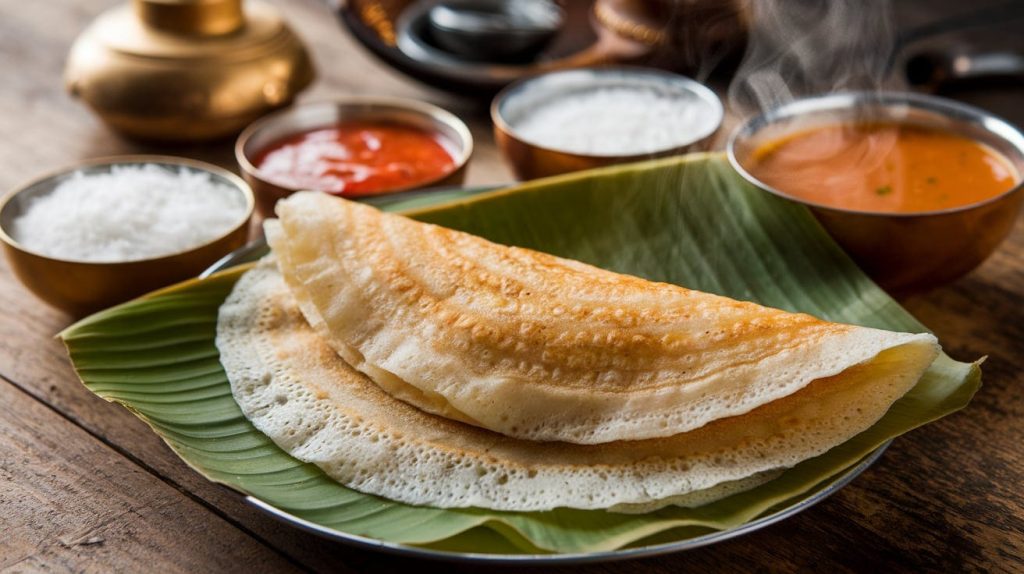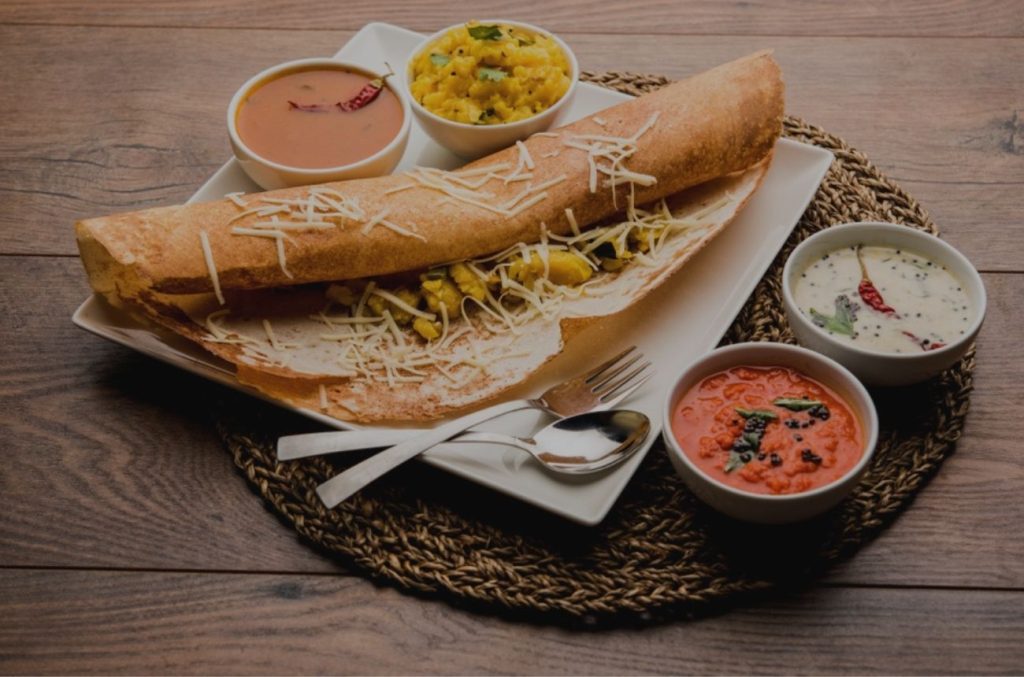Learn about Is Masala Dosa Healthy. Discover if masala dosa is a healthy choice. Discover if masala dosa is healthy. Learn about its nutritional benefits, calorie content, and tips for a balanced, nutritious meal.
Introduction
Dosa is a common dish prepared with binge into rice batter which has been fermented; it is crunchy and delicate at the same time. Sambhar (spicy soup together with lentils) and chutneys accompany this dish most times.
There are many kinds of dosas; masala dosa is one among them which has a filling of spicy potatoes. They are often taken as breakfast or snacks in several areas in India as it is nutritionally rich and delectable.
Is Masala Dosa Healthy?
Yes, homemade masala dosa can be a nutritionally balanced option. The dosa batter that is prepared from rice along with lentils, offers an excellent source of proteins and fibers. The stuffing, which is usually made from potatoes, onions as well as spices contributes vitamins and minerals.
Masala dosa can be more healthy by using less oil and including vegetables in the filling. However, oil and refined food need moderation because an excess utilization of them can lead to health problems. Homemade masala dosa which is balanced can be nutritious, combining various flavors with essential nutrients for a complete meal that satisfies.

Health Benefits of Masala Dosa
1. Rich in Protein and Fiber
The base of a masala dosa comprises of rice and lentils that are high in proteins and fibers. Therefore, protein helps to build muscle and repair tissues while fiber helps in digestion; it also aids in keeping the weight within healthy limits by making one feel full.
2. Essential Vitamins and Minerals
The creamy potato filling contains high amounts of potassium and also has vitamins such as C and B-type vitamins. All these substances maintain heart function and increase immunity levels while they also play a role in energy creation hence bringing about wellness at large.
3. Anti-Inflammatory Spices
Potato stuffing has spices such as cumin, turmeric, and coriander which help in reducing any inflammation. Besides their nutrient density, these spices also decrease swelling while promoting digestion thereby delivering even more health advantages
4. Low in Saturated Fat
If you add very little oil while making masala dosa then it becomes a fairly low saturated fat eatable. This may cause improved heart functioning and lesser chances of getting attacked by various heart-related problems. The positive impact can be increased by selecting more appropriate ways of preparing food.
5. Supports Digestive Health
Fermented dosa batter along with spiced fillings aid in digestion. Fermentation results in the production of useful bacteria which help in improving gut health and at the same time other digestion problems are relieved by spices.
6. Versatile and Balanced Meal
Masala dosa is one of the best options that can be eaten with high-quality nutrients such as sambar, chutneys, etc., making it richer in terms of nutrition. The type of food is hence versatile and also balanced which implies that it safely fits in a health-conscious person’s menu.
Tips for Making Dosa Consumption Healthier
- Choose Whole Grains: For dosa batter, you may use brown rice and oats as whole-grain replacements. Whole grain foods are rich in fiber, vitamins, and minerals than refined foods. Consequently, they improve digestion and offer weight-controlling support allowing one to be always dynamic.
- Incorporate Legumes: To enrich with protein, you can include legumes in your Dosa batter such as lentils and chickpeas. These legumes have a lot of iron and folate in them. By including legumes in your dosa mix, it becomes much more nutritious thereby making it a good balanced meal choice.
- Use Healthy Cooking Methods: Grow food preparation methods that reduce excess intake of fat and calories. For instance, using a non-stick frying pan or cooking spray instead of oil will minimize its quantity in food recipes. Always cooking dosas with such methods of preparation helps to reduce their fat content while retaining crispness.
- Limit Oil Usage: Too much oil will only add unwanted calories as well as bad fats to your dosa. It’s best if you cook with little oil or use heart-friendly ones such as olive oil. In that manner, you can lower calorie consumption while still retaining taste and feel hence making a wholesome dish.
- Add Veggies: Different types of vegetables may be mixed with dosa batter or fillings because they help them absorb vitamins, minerals, and fibers. Incorporating spinach, carrots, and bell peppers into dosa enhances its taste and structure while boosting its nutrient value.
- Watch The Accompaniments: Dosa, with chutneys and sambar as sides; Is indeed a concern to take note of. For better control of sugar additions and unhealthy fats, try low-fat or make it yourself at home. To keep your dosa meal balanced and healthy, go for the accompaniments that are all nutrient-filled.
- Experiment With Millets: Adding millets such as ragi or bajra into your dosa batter will provide you with extra nutrient advantages. Compared to regular rice, millets have higher minerals, dietary fiber, and protein contents thereby making them an excellent source of healthful diet. Aside from improving the health benefits of dosa in terms of nutrition; it also adds various flavors to it.
- Ferment Wisely: Fermented dosa batter has an improved nutritional value due to the increase in good bacteria and the decline of anti-nutrients. For better gut health and overall well-being, the batter should undergo fermentation for a specific duration so that it can be easily digested and have more nutrients absorbed from it.
- Balance With Nutrient-Rich Foods: Healthy options for dosas include lean proteins, fresh salads, and fruits. Thus, incorporating a variety of essential nutrients in the meal will be achieved through this balanced approach. The use of wholesome foods with dosas can improve general nutrition and promote the development of a healthy diet.
Alternative Dosa Varieties to Rice Dosa
1. Oats Dosa
Using OATS as the main ingredient, oats dosa is a perfect replacement for rice. Oats are high in fibers, vitamins, and minerals which enhance digestion and help one’s heart function. While the textural qualities of this dosa differ somewhat it remains an entirely wholesome and heart-friendly dish that requires nearly no effort to prepare for consumption by people who want to have nutritious food in their lives.
2. Quinoa Dosa
In its batter, quinoa dosa employs quinoa, a perfect source of protein. It is also rich in iron and magnesium and provides all the necessary amino acids that are required. Increasing the protein content in your meal, what this dosa tastes like is different from others.
3. Green Gram Dosa
The basic constituent of green gram dosa is green gram (moong dal), which has high fiber and protein. This kind of variety is simple to digest which helps in controlling weight and ensuring heart health. Besides, dosa is known for its unique flavor and smoothness hence making it an alternative that is not only nutritious but also contains large amounts of proteins.

4. Sprout Dosa
In sprout dosa, sprouted grains or legumes are added to the batter, making it nutritionally richer with the rise in vitamins and enzymes. Protein, vitamins, and minerals become more available in this kind of dosa because sprouting enhances their digestibility. The result is a unique texture and a mild nutty taste.
5. Jowar Dosa
Jowar dosa is heard of as mashandhu by many people. This dish is gluten-free and made from jowar grains which are sorghum flour enriched with fibers, minerals, and proteins. Through the consumption of jowar, individuals can regulate their blood glucose levels as well as improve digestion. It has an earthy taste with some thickness, thus it is a heavy dish but nutritious.
FAQs
Are there any dietary restrictions to consider with masala dosa?
On the whole, masala dosa is an excellent option for those following vegetarian diets; but when it comes to gluten intolerance a careful selection of the components is paramount.
All necessary dietary requirements should not be overlooked while modifying the method; for example, much less oil can be used or omitting certain spices altogether.
Can I freeze masala dosa?
Absolutely! You can keep masala dosa in the freezer. The cooked dosas should be placed in an airtight container using layers of parchment paper in between them, then they should be frozen. To keep crispness, it is best that you reheat in a toaster oven or pan. Avoid using microwaves so that you won’t make it soggy.
What are the best accompaniments for masala dosa?
Sambar (pungent dahl), along with coconut chutney, tomato chutney, or mint chutney, complements masala dosa excellently. These accompaniments give taste and extra nutrition to the meal, making it better as it maintains the health benefits.
Conclusion
Masala dosa can be an element of a healthy diet, provided that it is prepared with careful consideration. Its nutritional advantages can be improved by balancing it with vegetables and restricting the use of oil. In general, this dish is rich in flavor; hence if taken in moderation, it would suit the requirements of a healthy eating regimen.
